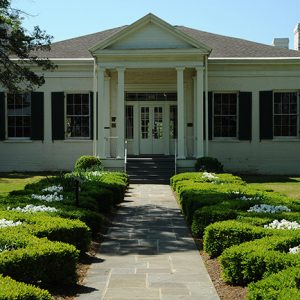calsfoundation@cals.org
Curran Hall
aka: Little Rock Visitor Information Center
aka: Walters-Curran-Bell House
Curran Hall, sometimes known as the Walters-Curran-Bell House, stands at 615 East Capitol Avenue in the MacArthur Park Historic District and is one of the few remaining antebellum landmark properties in Little Rock (Pulaski County). Dating back to 1842, the house was constructed during the city’s first building boom, which reached its peak around 1842 and faded out with the depression of 1843. It was listed on the National Register of Historic Places on January 1, 1976.
According to widely accepted tradition, Curran Hall was constructed in the Greek Revival style by noted Greek Revival architect Gideon Shryock, who designed the Kentucky State Capitol as well as the Old State House, making this house of particular significance. The original one-story structure of the house was made with walls three bricks thick, cypress interior and exterior, and solid wood trimming and was settled on a raised foundation. Perhaps the most outstanding feature of the building is its symmetrical appearance, conveyed by the five-bay front façade made up of four six-over-six sash windows. Also included in the original design over a small central portico was a low hipped roof supported by four Doric columns and two Doric pilasters displayed on the north-facing front of the house. The original interior floor plan was a four-room, central-hall type, although it was later added to by various owners. Each of the four rooms contains its original fireplace and classically designed mantel. The original interior of the house remains relatively undisturbed; however, the two rear additions have been fully transformed. Colonel Ebenezer Walters’s office (the southeast addition) is currently divided into three rooms, and the porch addition, originally used as servants’ quarters, houses the kitchen and utility room. In 1848, a children’s playhouse was constructed at the back of the house. The existing playhouse was reconstructed in the 1960s with materials from various historic houses in Little Rock.
Over the years, Curran Hall has been owned by several important Arkansas families. The house was originally built by Colonel Ebenezer Walters for his young bride, Mary Starbuck. She died shortly before the completion of the home, and, as it was seen to hold too many painful memories for Col. Walters, it was promptly sold in 1843 to David J. Baldin. In 1849, Baldin sold the house to a young lawyer, James Moore Curran, from whom the house gets its name. Curran bought the property for his wife, Sophia Fulton, daughter of William Savin Fulton, the last territorial governor of Arkansas and the state’s first U.S. senator. They only remained in residence for a short while as James Curran died suddenly in October 1854, ending his promising law career. Sophia remarried, and she and her new husband, George Watkins, vacated the premises shortly after the beginning of the Civil War.
At the end of the Civil War, the property again changed hands. This time it was purchased by Jacob Frolich, who was a printer, a Confederate veteran, and a member of the night-riding Knights of the White Camelia. Frolich was later elected to three consecutive terms as the post-Reconstruction secretary of state in Arkansas (1879–1885). The time period he spent in the house was a tense one because of his active opposition to policies of the Arkansas Reconstruction government. During this time, the house was equipped with several tactically placed trapdoors. He evacuated the property for a short while after he was indicted for the murder of a Mr. Parker, a reputed informer for the Reconstruction government. Frolich avoided arrest by escaping to Montreal, Canada, but returned to Arkansas after the demise of the government, at which time he was acquitted of the charges against him. He resold the property in 1881.
Curran Hall’s next occupant was Mary Eliza Bell, the daughter of William E. Woodruff, founder of the Arkansas Gazette. Her descendants, the Fred L. Tate family, continued possession of the house (the last inhabitant, Averell Tate, moved out in 1993) until the City of Little Rock and the Little Rock Advertising and Promotion Commission saved the residence from demolition in 1996. After the purchase of the house, the Little Rock Visitor Information Center Foundation led the way in renovating it for use as Little Rock’s first official visitor information center. After six years and $1.4 million, the house was formally opened to the public as the Little Rock Visitor Information Center on May 18, 2002.
For additional information:
Caillouet, Linda S. “Curran Hall Revived as Visitors Center.” Arkansas Democrat-Gazette, November 25, 2000, p. 1B, 2B.
———. “LR Hopes Visitors Center Taps Gold Rush.” Arkansas Democrat-Gazette, May 30, 1997, p. 1B.
“Curran Hall.” National Register of Historic Places Registration nomination form. 1976. On file at the Arkansas Historic Preservation Program, Little Rock, Arkansas.
Kayla Kesterson
Conway, Arkansas
 Curran Hall
Curran Hall 



Comments
No comments on this entry yet.